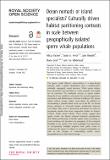Ocean nomads or island specialists? Culturally driven habitat partitioning contrasts in scale between geographically isolated sperm whale populations
Abstract
The sperm whale (Physeter macrocephalus) is a deep-diving cetacean with a global distribution and a multi-leveled, culturally segregated, social structure. While sperm whales have previously been described as ‘ocean nomads’, this might not be universal. We conducted surveys of sperm whales along the Lesser Antilles to document the acoustic repertoires, movements and distributions of Eastern Caribbean (EC) sperm whale cultural groups (called vocal clans). In addition to documenting a potential third vocal clan in the EC, we found strong evidence of fine-scale habitat partitioning between vocal clans with scales of horizontal movements an order of magnitude smaller than from comparable studies on Eastern Tropical Pacific sperm whales. These results suggest that sperm whales can display cultural ecological specialization and habitat partitioning on flexible spatial scales according to local conditions and broadens our perception of the ecological flexibility of the species. This study highlights the importance of incorporating multiple temporal and spatial scales to understand the impact of culture on ecological adaptability, as well as the dangers of extrapolating results across geographical areas and cultural groups.
Citation
Vachon , F , Hersh , T A , Rendell , L , Gero , S & Whitehead , H 2022 , ' Ocean nomads or island specialists? Culturally driven habitat partitioning contrasts in scale between geographically isolated sperm whale populations ' , Royal Society Open Science , vol. 9 , no. 5 , 211737 . https://doi.org/10.1098/rsos.211737
Publication
Royal Society Open Science
Status
Peer reviewed
ISSN
2054-5703Type
Journal article
Description
Funding: This research was funded by the National Geographic Society (grant no. NGS-62320R-19-2), the Agoa Sanctuary, the Natural Sciences and Engineering Research Council of Canada and the Animal Behavior Society.Collections
Items in the St Andrews Research Repository are protected by copyright, with all rights reserved, unless otherwise indicated.

